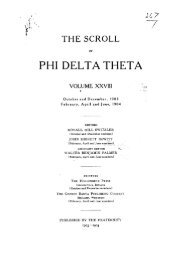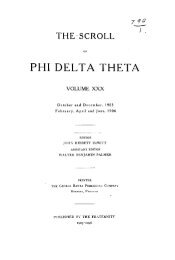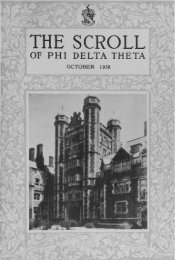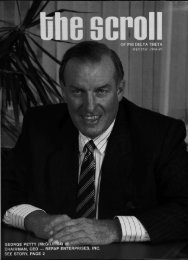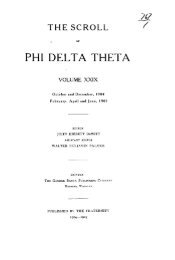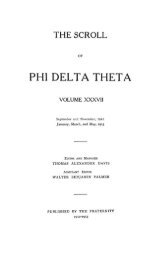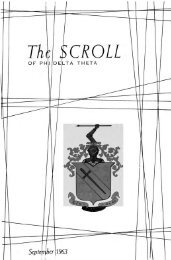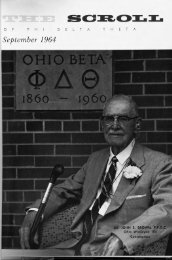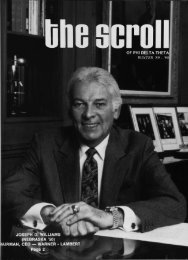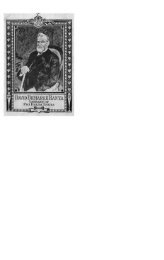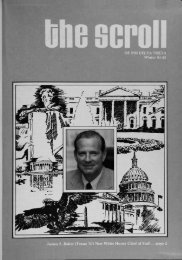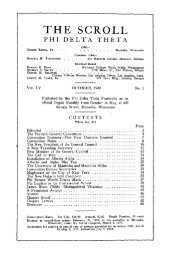1953–54 Volume 78 No 1–5 - Phi Delta Theta Scroll Archive
1953–54 Volume 78 No 1–5 - Phi Delta Theta Scroll Archive
1953–54 Volume 78 No 1–5 - Phi Delta Theta Scroll Archive
Create successful ePaper yourself
Turn your PDF publications into a flip-book with our unique Google optimized e-Paper software.
THE SCROLL of <strong>Phi</strong> <strong>Delta</strong> <strong>Theta</strong> for May, 1954 397<br />
giving up come June. "I suggested that I<br />
would like to have a job with the Saturday<br />
Evening Post, since I felt then, as I do now,<br />
that it's more of an honor to work for the<br />
Post than any other publication, and that<br />
the prestige deriving from being a member<br />
of the Post staff is an entree into any place,<br />
high or low."<br />
Through Graeme Lorimer (whom "Slim"<br />
Steele, a classmate and Brother <strong>Phi</strong>, calls<br />
"Red," and who had been editor of the<br />
Red and Blue at Pennsylvania when Pete<br />
was its art editor, and who is a son of<br />
George Horace Lorimer, then editor of the<br />
Post), Pete was granted an interview with<br />
Mr. Lorimer.<br />
"After talking to me for a while," Pete<br />
says, "Mr. Lorimer offered me a job on the<br />
Post. 1, in turn, offered to go to work for<br />
the Post in June when I finished one more<br />
semester at Pennsylvania. 'If you want this<br />
job you'll take it now,' Mr. Lorimer told<br />
me. 'I know why you want to go back to<br />
Pennsylvania. You just want to run on the<br />
track team.'<br />
"I was in love, I wanted to get married,<br />
I wanted to work for the Post, so I gave up<br />
my plan to return to the university and<br />
went to work for the Post instead. I've often<br />
wondered what would have happened if I<br />
had taken a stronger stand and had refused<br />
to come to the Post until June. I'll never<br />
know. The trouble was, I didn't know<br />
whether Mr. Lorimer was bluffing or not,<br />
and I didn't want to take the chance.<br />
"Quite understandably," Pete reflects,<br />
"those at the University of Pennsylvania<br />
thought that I used them as a cat's paw in<br />
getting the job, and I was in the dog house<br />
on the campus for a long time after that."<br />
Pete's first years on the Post were spent<br />
reviewing "second-class manuscripts." This<br />
is slang peculiar to Post editors \\hich,<br />
in effect, classifies such manuscripts as those<br />
which come from the thousands of housewives,<br />
elevator men, and college English<br />
graduates who would like to become professional<br />
writers. "First-class" manuscripts<br />
are those which come to the Post, and to<br />
other top-flight publications, from author's<br />
agents, writers who had previously made<br />
the magazine, or from book publishers.<br />
When the woman who was Art Editor left<br />
to get married in 1930, Pete took her place.<br />
He regarded this as merely a change in occupation;<br />
not really a promotion, since he'd<br />
been listed on the masthead as an Associate<br />
Editor. His first by-line article appeared in<br />
the Post in 1939.<br />
In a candid appraisal, Pete says, "The<br />
real truth about my accomplishments as art<br />
editor is that I was never really art editor.<br />
The two editors for whom I worked in the<br />
art department, Lorimer and Stout, were<br />
both the actual art editors. In fact, I<br />
worked up a roaring case of stomach ulcers<br />
in my battle with and for the Post format."<br />
During his tenure as Art Editor, however,<br />
the Post title type was changed from<br />
the old-style gray type to solid black, and<br />
such modern touches as bleed pages and<br />
color, both two and four-color, were injected.<br />
Pete became a whole-time staff-writer in<br />
1942, when Ben Hibbs succeeded Wesley<br />
Stout as Post Editor. When Hibbs took<br />
over, a succession of changes were made, the<br />
first of which became physically apparent in<br />
the issue of May 30, 1942. Describing these<br />
changes, Ashley Halsey, Jr., in his official<br />
Short History of The Saturday Evening<br />
Post, refers to the "amazing metamorphosis<br />
(which saw) W. Thornton (Pete) Martin,<br />
who had been art editor under Stout,<br />
(switching) to a writing editorship (to)<br />
become one of the magazine's most prolific<br />
article contributors."<br />
"I finally had to have a stomach-ulcer<br />
operation," Pete says, "and I don't know<br />
how many art editors have Caesarian scars<br />
up and down their bellies as a result of their<br />
operation. .All I know is that I have. This<br />
situation has been different under Ben<br />
Hibbs as Editor-in-Chief, and Bob Fuoss as<br />
Managing Editor. The present art editor is<br />
art editor in fact as well as in title."<br />
Everyone of his associates calls Pete a<br />
"good reporter," and it is as such that Pete<br />
would like best to be known. He has no<br />
desire to write the Great American <strong>No</strong>\el,<br />
or e\en a play. "I started as a fiction ^vriter,"<br />
he says, "but the trouble was I had no plot<br />
sense. I was fairly good at mood and dialogue,<br />
but my plots were mostly incidents<br />
blown up into stories. The editorial \ote<br />
was too often, 'WeW done, but no story.' As



